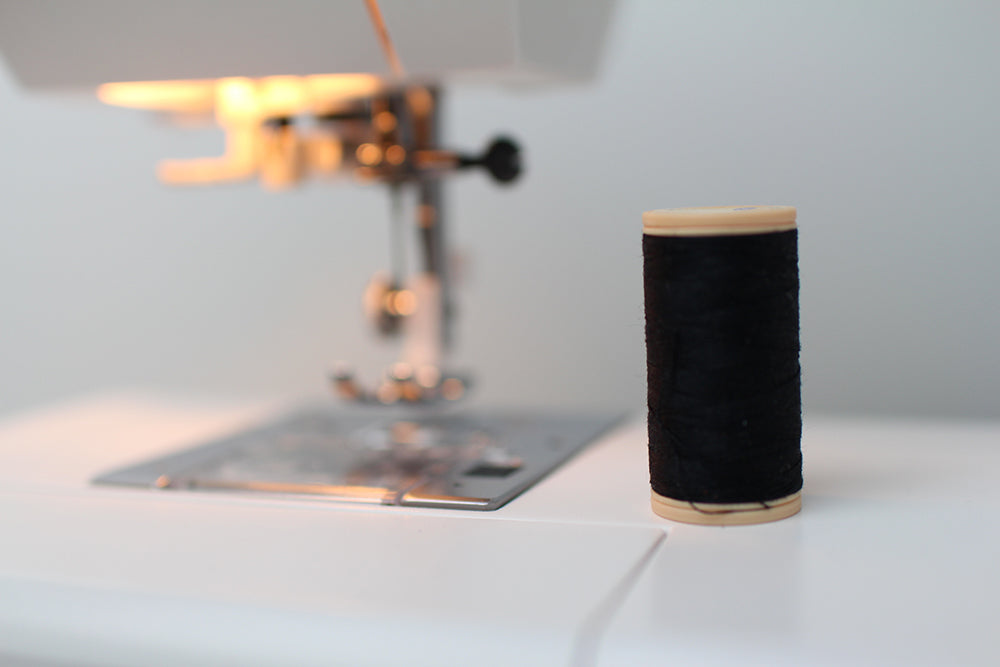Different sewing threads and their uses…
With a large variety of different threads available it can be a minefield finding the right thread for the job, especially if you're relatively new to sewing.
What is the difference between polyester, silk and cotton thread and when should they be used? What are the benefits of each thread, and above all does thread choice matter?
There are a number of different thread brands available. I personally work with Gutermann, however you will find a variety of thread companies offering a similar variety of options and the same rules apply.
When should I use polyester thread?
Polyester is your go-to everyday thread, it can be used on a variety of different projects for both hand and machine sewing. Polyester thread has a small amount of ‘give’ and is therefore suitable for use with stretch and knit fabrics. It is strong and durable so can be used on projects that will receive a great deal of wear and tear. It is generally available in the largest colour range.
I personally work with Gutermann Sew All 100% Polyester thread for the majority of projects. This thread is available in a number of different sized spools, 100 metres, 250m, 500m and 1000m, as well as a wide colour range. When working with Gutermann threads be sure you pick up the right thread when shopping, this is distinguished by the colour at the end of the spool. The Sew All 100% Polyester thread has a cream or white end (100m – cream, 250m, 500m and 1000m – white).

When should I use cotton thread?
Cotton thread is the perfect accompaniment to 100% cotton fabric and is therefore most commonly used in patchwork and quilting. Some sewing purists believe that you should use the same thread as the fabric yarn content, so cotton thread should be used to sew cotton fabric.
Cotton thread has very little ‘give’ and is weaker than other available threads, such as polyester. It can be perfect for use on lightweight, delicate projects as generally speaking you want the thread to be weaker than the fabric you're working with. Any stress on seams should cause the thread to break, rather than the fabric to tear.
I personally don’t get much use from cotton thread simply because I don’t have a large variety of colours to hand. Although it’s a nice to have, it’s rarely a ‘must-have’ for dressmaking projects.

Sewing with silk thread?
Silk is a beautiful thread to work with; both on and off the sewing machine. I predominately use silk thread when hand sewing; finishing hems, basting (tacking), buttonholes and tailoring work. Silk thread is very smooth so travels through even the lightest most delicate fabrics without leaving a mark, as well as being very strong (especially when used in conjunction with beeswax), it is a superb choice for a large variety of hand sewing projects.
Other uses include decorative stitching. On the sewing machine I use silk thread on the top spool when quilting Chanel style jackets. The thread is wonderful at sinking into the textured loose weave.

Uses for topstitching thread?
Topstitching thread is as the name suggests suitable for topstitching. Although standard thread can be used for topstitching the thicker topstitching thread is perfect for use on heavier weight fabrics and provides a decorative look to stitching.
When completing topstitching be sure to work with topstitching thread on the top of the sewing machine and (for most domestic sewing machines) a normal bobbin. You will require a topstitching needle so that the eye of the needle is large enough for the thread to pass through. Try increasing your stitch length to get a better finish; generally speaking the thicker the fabric the larger the stitch length required (the standard stitch length of 2-2.5mm will disappear in thick fabrics such as denim and canvas).

When to use extra strong thread?
Although extra strong thread is not suitable for the majority of every day sewing projects it does it have uses. Especially when working with home furnishing projects. The thread is constructed as a thicker, stronger polyester thread that can take a great deal of wear and tear. It is perfect for use on denim, leather and canvas fabrics, as well as rugged repair work.
TIP: It is possible to use extra strong thread for topstitching if you don’t have a suitable topstitching colour to hand.

Sewing with decorative threads (metallic & embroidery)?
Metallic and embroidery threads are fabulous for machine or hand embroidery, creating decorative detailing on garments and home decor projects. With a large variety of different threads available and a superb colour range you should be overwhelmed with choice.
Remember to use a specialist needle when working with metallic and embroidery threads to prevent shedding and snapping of the thread.
Choosing the best thread?
So what do you need to think about when choosing the best thread for your project:
- think about fabric properties, is your fabric woven or knitted, lightweight or heavyweight?
- the weight of the thread should match the weight of the fabric
- some sewing purist recommend matching the thread to the fibre content of the fabric (cotton thread to cotton fabric)
- most of the time an all purpose polyester thread will work
- try and stay away from cheap threads, when working with threads you generally get what you pay for
- colour choice is up to you; do you wish to achieve a colour match or use thread in a contrasting colour as decoration
Remember… MOST of the time all purpose polyester thread will do the job, and you get what you pay for.

